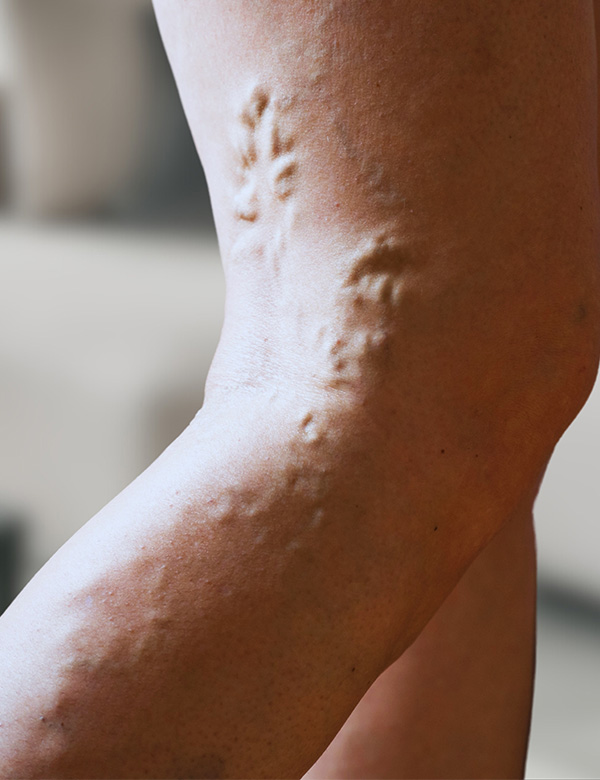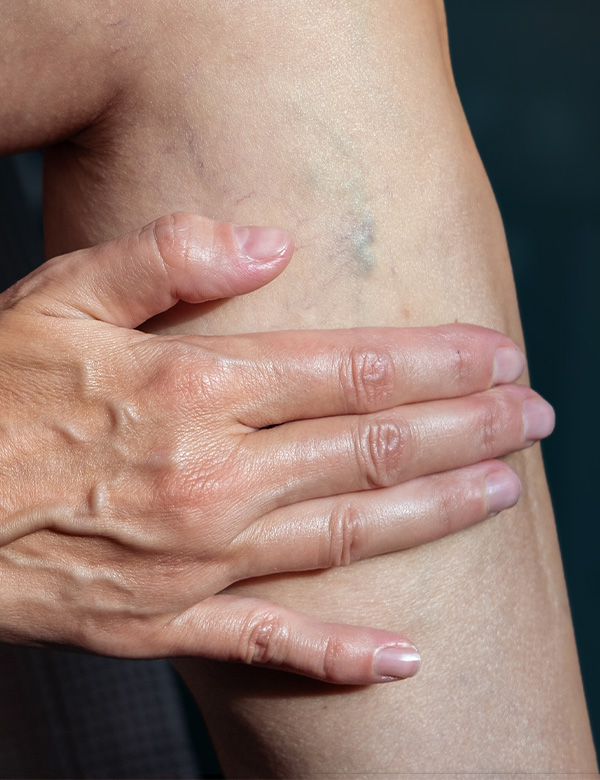Treating Arteriosclerosis
Recognizing and treating arteriosclerosis – by a vascular specialist at the Derma Medical Clinic in Zurich – Sihlcity
Arteriosclerosis
Chronische Abszesse und schmerzhafte Knoten durch erfahrenen Hautarzt abklären und behandeln in der Derma Medical Clinic in Zürich - Sihlcity
Leg pain when walking, cold feet, or poorly healing wounds: Recognize and treat vascular calcification, vascular inflammation, or non-healing wounds with modern vascular diagnostics
Examinations
Vascular screening
Vascular ultrasound
Procedure
Initial consultation
Ultrasound
Evaluation
Duration
approx. 45 minutes
Changes in the arteries at a glance
Why an artery examination?
Arteries are blood vessels that transport oxygen and nutrients from the heart to the entire body.
If they become narrower due to arteriosclerosis (calcification), less blood reaches the legs, arms, or organs: this results in exertion-dependent pain, usually when walking, cold feet, or poorly healing wounds.
An inflammation of the artery wall can lead to pain, swelling, or functional disorders.
An injury or tear means an acute circulatory disorder.
A pathological dilation of an artery (aneurysm) often goes unnoticed but can cause life-threatening bleeding if it ruptures.
An artery examination can detect such changes in time before permanent damage occurs.
An examination is recommended if you…
- experience leg pain when walking or have to take regular breaks (“intermittent claudication”)
- have cold feet or wounds on your legs that heal poorly
- had sudden visual or speech disorders
- suffer from dizziness, headaches or fainting spells
- feel your abdomen or back radiating pain
- have several risk factors: smoking, high blood pressure, diabetes, elevated blood lipid levels, family history of heart attack, stroke, or aneurysm
- notice a sensible or visible throbbing of a vessel
- have a known aneurysm (enlargement of an artery) or risk factors for aneurysm formation

Why an artery examination?
Arteries are blood vessels that transport oxygen and nutrients from the heart to the entire body.
If they become narrower due to arteriosclerosis (calcification), less blood reaches the legs, arms, or organs: this results in exertion-dependent pain, usually when walking, cold feet, or poorly healing wounds.
An inflammation of the artery wall can lead to pain, swelling, or functional disorders.
An injury or tear means an acute circulatory disorder.
A pathological dilation of an artery (aneurysm) often goes unnoticed but can cause life-threatening bleeding if it ruptures.
An artery examination can detect such changes in time before permanent damage occurs.
For whom is the clarification of arteriosclerosis useful?
An examination is recommended if you…
- experience leg pain when walking or have to take regular breaks (“intermittent claudication”)
- have cold feet or wounds on your legs that heal poorly
- had sudden visual or speech disorders
- suffer from dizziness, headaches or fainting spells
- feel your abdomen or back radiating pain
- have several risk factors: smoking, high blood pressure, diabetes, elevated blood lipid levels, family history of heart attack, stroke, or aneurysm
- notice a sensible or visible throbbing of a vessel
- have a known aneurysm (enlargement of an artery) or risk factors for aneurysm formation
Treatment
What Happens During the Examination of the Arteries?
First, we talk about your symptoms, risk factors, and the situations in which the problems occur.
At the Derma Medical Clinic, our vascular specialist uses a unique screening before each vascular ultrasound: With cuffs and small sensors on the arms, legs, and toes, blood flow is measured completely painlessly in just a few minutes. Vascular problems such as calcifications or circulatory disorders often show up there first, even before symptoms occur. This allows even early changes to be reliably detected – a diagnostic standard that is otherwise only offered in specialized vascular centers.
The blood flow is then checked with vascular ultrasound (color duplex, Doppler). This allows us to see in real time whether an artery is freely passable, narrowed, or blocked.
If necessary, we supplement further measurements or arrange for further imaging (e.g., CT/MR angiography) and a blood sample.
What Happens after the Examination?
We explain the findings in an understandable way and show whether there is a vascular narrowing due to calcification or another cause (e.g., vascular inflammation, injury). Depending on the result, we discuss the next steps: observation, monitoring, medication adjustment, or – if necessary – planning a small, gentle procedure via tiny skin incisions (minimally invasive) or through an operation.
How does the examination of arteriosclerosis proceed?
Initial consultation, blood flow measurement, assessment
We discuss your symptoms, risk factors, possible family history, and make a determination of the blood flow.
Vascular diagnostics
First, a vascular screening is performed for the early detection of vascular changes. Using vascular ultrasound, we then check the blood flow in the affected arteries.
Evaluation & therapy
If there is an abnormality, the next steps, e.g., monitoring, drug treatment, or therapy planning, are initiated directly.

At the Derma Medical Clinic, the examination and treatment of vascular diseases is carried out by
Dr. Andreas Gutwein
, specialist in angiology and general internal medicine, FA phlebology. He is a specialist in vascular diseases and has many years of experience in the diagnosis and treatment of changes in the arteries.

Dr. med. Andreas Gutwein
Specialist in Angiology and General Internal Medicine FMH
Expert in Vascular Medicine & Men’s Health

Dr. med. Benjamin Miller
Board-certified Specialist in Dermatology and Venereology FMH
What you can expect from us
Angiology: Vascular medicine
Angiology is the specialist discipline for veins, arteries, and lymphatic vessels in medicine. At the Derma Medical Clinic, vessels are examined exclusively by an experienced specialist in angiology.
Vascular ultrasound: precise diagnostics
The vascular ultrasound shows the blood flow in real time and recognizes whether an artery is changed. The examination is painless, without radiation exposure, and takes place directly in our clinic. You will find out the result immediately, without waiting.
Vascular medicine meets dermatology
Many vascular diseases first become noticeable on the skin – through swelling, discoloration, or visible veins. In the Derma Medical Clinic, vascular medicine and dermatology therefore complement each other perfectly.
Everything under one roof
You receive diagnosis, medical treatment, and cosmetic support in one place. This means you have fixed contact persons, short distances, and coordinated care, from the initial examination to aftercare.
Do you have complaints such as pain in the legs when walking, cold feet, or poorly healing wounds?
Have it clarified whether a vascular disease is behind it, and book your appointment now at the Derma Medical Clinic in Zurich-Sihlcity.
FAQ – Frequently asked questions about changes in the arteries
Which symptoms indicate a circulatory disorder of the arteries?
Typical signs of a circulatory disorder are pain in the legs when walking (“intermittent claudication”), cold feet, poorly healing wounds, or sudden visual and speech disorders.
However, vascular diseases do not only affect constrictions: Dilations such as aneurysms can also occur. They often do not cause any symptoms for a long time but can become dangerous if they remain undetected.
How does an examination of the arteries by the angiologist proceed?
First, your symptoms and risk factors are discussed. This is followed by examinations, followed by a vascular screening for blood flow measurement, as well as a vascular ultrasound (Doppler or duplex sonography).
Why is an additional screening performed at the Derma Medical Clinic before each vascular ultrasound?
We use the AngE™ ABI+ Screening because it measures blood flow in the arms, legs, and toes precisely and painlessly within a few minutes. Vascular problems such as calcifications or circulatory disorders often show up there first, even before symptoms arise. This gives you a particularly reliable examination – a diagnostic standard that is otherwise only offered in specialized vascular centers.
What is duplex sonography (vascular ultrasound) and when is it used?
Duplex sonography is an ultrasound examination that makes the blood flow and vessels visible in a highly magnified form. This allows the vessels to be assessed in detail. It is used to clarify constrictions/dilations, calcifications (arteriosclerosis), or occlusions of the carotid, abdominal, and leg arteries.
How reliable is the ultrasound examination of the carotid artery?
Duplex sonography of the carotid artery (carotid) is a very meaningful method and the means of choice to detect constrictions or deposits early and to estimate stroke risks.
From when should the carotid arteries be examined?
An examination is recommended for people with risk factors (e.g., high blood pressure, diabetes, smoking, family history of cardiovascular disease) or existing vascular diseases – regardless of age – so that possible treatments or precautionary steps can be taken early.
Which preventive examinations are useful for arteriosclerosis risk (calcification of the arteries)?
In addition to blood tests for blood lipids, blood flow measurements with blood pressure cuffs and sensors on the outside of the body as well as ultrasound examinations are among the most important preventive measures.
Is a vascular examination painful and do you have to expect risks?
The common examinations such as ultrasound are painless and without radiation exposure. CT or MR angiographies may only be necessary for special questions.
How often should the arteries be checked?
That depends on the individual risk. In the case of confirmed vascular disease and known risk factors, a check-up every one to two years is recommended, otherwise according to medical assessment.

